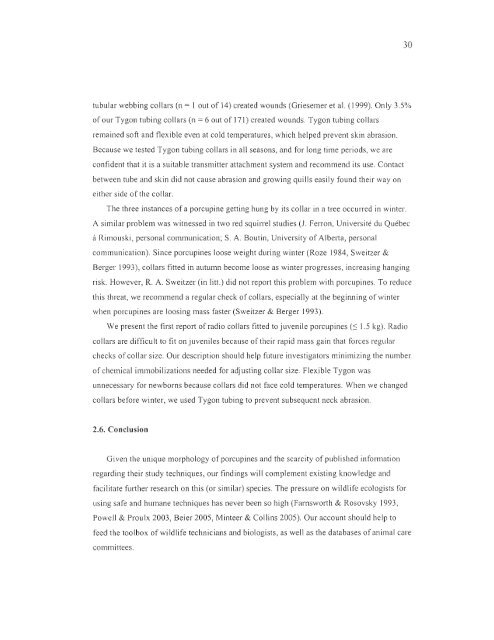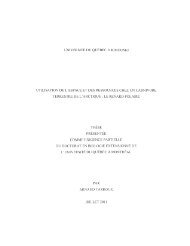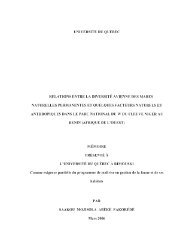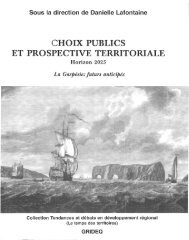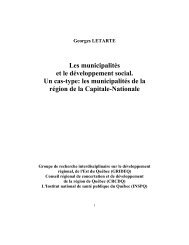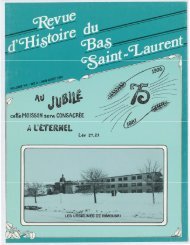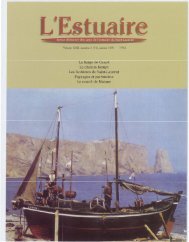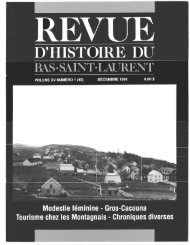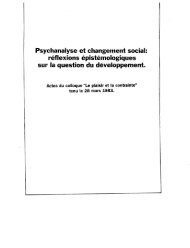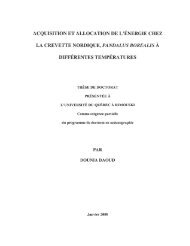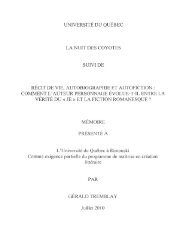influence du climat et de la prédation sur l'utilisation de l'habitat et la ...
influence du climat et de la prédation sur l'utilisation de l'habitat et la ...
influence du climat et de la prédation sur l'utilisation de l'habitat et la ...
Create successful ePaper yourself
Turn your PDF publications into a flip-book with our unique Google optimized e-Paper software.
30<br />
tubu<strong>la</strong>r webbing col<strong>la</strong>rs (n = 1 out of 14) created wounds (Gri esemer <strong>et</strong> al. (1999). Only 3.5%<br />
of our Tygon tubing col<strong>la</strong>rs (n = 6 out of 17 1) created wounds. Tygon tubing col<strong>la</strong>rs<br />
re mained soft and fl exible even at cold temperatures, whi ch helped prevent skin abrasion.<br />
Because we tested Tygon tubing col<strong>la</strong>rs in ail seasons, and for long time peri ods, we are<br />
confi <strong>de</strong>nt that it is a suitable transmitter attachment system and recommend its use. Contact<br />
b<strong>et</strong>ween tube and skin did not cause abrasion and growin g quills easil y fo und thei r way on<br />
either si<strong>de</strong> of the col<strong>la</strong>r.<br />
The th ree instances of a porcupine g<strong>et</strong>ting hung by its col<strong>la</strong>r in a tree occurred in winter.<br />
A simi<strong>la</strong>r problem was witnessed in two red squilTel studies (J. Ferron, Université <strong>du</strong> Québec<br />
à Rimouski, personal communication; S. A. Boutin, University of A lberta, personal<br />
communicati on). Since porcupines loose weight <strong>du</strong>ring w inter (Roze 1984, Sweitzer &<br />
Berger 1993), col<strong>la</strong>rs fitted in autumn become loose as winter progresses, in creasin g hangin g<br />
ri sk. However, R. A. Sweitzer (i n litt.) did not report thi s problem with porcupines. To re<strong>du</strong>ce<br />
this th reat, we recommend a regu<strong>la</strong>r check of col<strong>la</strong>rs, especially at the beginning of winter<br />
when porcupines are loosing mass faster (Sweitzer & Berger 1993).<br />
We present the first repOli of radi o coll ars fitted to juvenile porcupines (:::; 1. 5 kg) . Radi o<br />
co l<strong>la</strong>rs are di fficult to fi t onjuveniles because of their rapid mass gain that fo rces regu<strong>la</strong>r<br />
checks of col<strong>la</strong>r size. Our <strong>de</strong>scription should help future investigators minimizin g the number<br />
of chemical immobilizati ons nee<strong>de</strong>d fo r adjusting col<strong>la</strong>r size. Flexibl e Tygon was<br />
unnecessary fo r newborn s because col<strong>la</strong>rs did not face cold temperatures. When we changed<br />
col<strong>la</strong>rs before winter, we used Tygon tubing to prevent subsequent neck abrasion.<br />
2.6. Conclusion<br />
Given the unique morphology of porcupines and the scarcity of published info rn<strong>la</strong>ti on<br />
regarding their study techniques, our fi ndings wi ll complement existing knowledge and<br />
fac ilitate ftui her research on this (or simi<strong>la</strong>r) species. The pres<strong>sur</strong>e on wildl ife ecologists fo r<br />
using safe and humane techniques has never been so hi gh (FarnswOli h & Rosovsky 1993,<br />
Powell & Proul x 2003, Beier 2005, Minteer & Collins 2005). Our account should help to<br />
feed the toolbox of wildlife technicians and biologists, as weil as the databases of an imal care<br />
committees.


